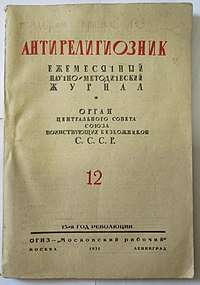Antireligioznik
Antireligioznik (Russian: «Антирелигиозник»; translation of the name: «Opponent of religion», lit. «Antireligionist») was a monthly scientific and methodical atheistic magazine in Russian, the organ of the Central Council of the League of Militant Atheists of the USSR, was published in Moscow from January 1926 to June 1941.[1]
 | |
| Editor | Y. M. Yaroslavsky |
|---|---|
| Categories | antireligious |
| Frequency | Monthly |
| Year founded | January, 1926 |
| Final issue | June, 1941 |
| Country | Soviet Union/Russia |
| Based in | Moscow |
| Language | Russian |
The editor of the publication is Y. M. Yaroslavsky. The "Antireligioznik" systematically covered the experience of the atheistic work of the League of Militant Atheists, placed articles on the history of religion and atheism, propagated scientific atheism, and developed from the Marxist standpoint the questions of criticism of religion.
"Antireligioznik" had a volume of about 130 pages, it consisted of author articles and headings "Anti-religious education in school", "Letters from the field", "Chronicle", "Methodology of anti-religious propaganda", "Criticism and bibliography." Among the authors of the magazine were V. D. Bonch-Bruevich, N. K. Krupskaya, A. T. Lukachevsky (deputy editor), activists of the League of Militant Atheists.[2] The section "Chronicle" contained detailed information on the activities of the League of Militant Atheists in various regions of the USSR. In the section "Criticism and Bibliography" reviews were published on books of anti-religious content (Ateist, Bezbozhnik and others), reviews of current publications on atheistic topics were given. The magazine developed the ideological foundations of mass atheist propaganda, directed primarily against Orthodoxy carried out through the lower organizations (cells) of the LMG. On the pages of the "Antireligioznik" were also published articles and notes directed against Catholicism and Protestantism.
Since 1960, the USSR published the magazine «Nauka i religiya» (Russian: «Наука и религия», lit. «Science and Religion»).[3][4]